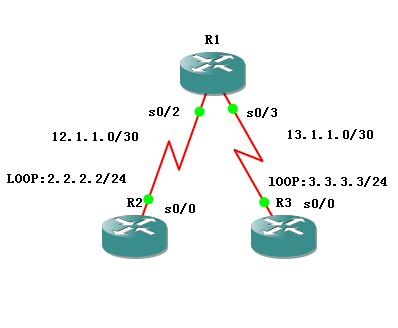理解并配置ODR路由
应用场景:
静态路由的缺点是,必须手工配置,同时当网络拓扑变化后需要手动更新;动态路由协议的缺点是,需要占用网络带宽和路由器资源。在包含数百个分支的Hub-spoke网络中,采用静态路由的配置工作量非常大,而采用动态路由则将占用大量的带宽和资源。
在这种情况下,可以采用第三种方式,按需路由(ODR),ODR使用cisco发现协议(CDP)在分支和中央路由器之间传输网络信息。
实验拓扑:

路由器配置:
R1
conf t
int s0/2
ip add 12.1.1.1 255.255.255.252
no shut
int s0/3
ip add 13.1.1.1 255.255.255.252
no shut
exit
router odr
R2
conf t
int s0/0
ip add 12.1.1.2 255.255.255.252
no shut
int loop 1
ip add 2.2.2.2 255.255.255.0
R3
conf t
int s0/0
ip add 13.1.1.2 255.255.255.252
no shut
int loop 1
ip add 3.3.3.3 255.255.255.0
ODR配置非常简单:
中央路由器上使用全局router odr配置ODR
末节点路由器无需任何配置
由于是基于CDP协议,CDP没60s发送一次,可以使用全局命令cdp timer调整
在R1上查看路由表,
Gateway of last resort is not set
2.0.0.0/24 is subnetted, 1 subnets
o 2.2.2.0 [160/1] via 12.1.1.2, 00:00:27, Serial0/2
3.0.0.0/24 is subnetted, 1 subnets
o 3.3.3.0 [160/1] via 13.1.1.2, 00:00:02, Serial0/3
12.0.0.0/30 is subnetted, 1 subnets
C 12.1.1.0 is directly connected, Serial0/2
13.0.0.0/30 is subnetted, 1 subnets
C 13.1.1.0 is directly connected, Serial0/3
可以看到2条o的路由(不要和OSPF的O混淆了)是R2和R3的LOOP网段
查看R2的路由表
Gateway of last resort is 12.1.1.1 to network 0.0.0.0
2.0.0.0/24 is subnetted, 1 subnets
C 2.2.2.0 is directly connected, Loopback1
12.0.0.0/30 is subnetted, 1 subnets
C 12.1.1.0 is directly connected, Serial0/0
o* 0.0.0.0/0 [160/1] via 12.1.1.1, 00:00:44, Serial0/0
有1条默认的指向R1的默认路由
总结:ODR虽然可以平衡一些静态路由和动态路由的优缺,但是仍有一定的局限:由于基于CDP协议,只适用cisco的设备,也只适用与中央-分支这类网络拓扑。